An Effective Method for Detecting Unknown Types of Attacks Based on Log-Cosh Variational Autoencoder
Abstract
:1. Introduction
1.1. Research Background
1.2. Related Work
1.3. The Contribution of the Work in This Paper
- We introduce a novel approach called the LVAE to identify unknown attacks. We developed this approach by incorporating an effective reconstruction loss term that utilizes the logarithmic hyperbolic cosine (log-cosh) function. This function accurately captures the intricate distribution of actual attack data, enabling the simulation of discrete features to model and enhance the detection of novel, unknown attacks.
- We employ eight different techniques for feature extraction and data classification. Throughout the experimentation process, we select the most accurate approach to ensure exceptional performance in identifying unknown attacks.
- Our model is trained using the latest CICIDS 2017 dataset, which includes a variety of real and unknown-type attacks. In comparison to several state-of-the-art methods, our LVAE approach demonstrates superior performance, surpassing recent advancements and significantly improving the detection rate of unknown attacks.
- Our method exhibits fast convergence and effectively minimizes the loss function within a short learning epoch.
2. Materials and Methods
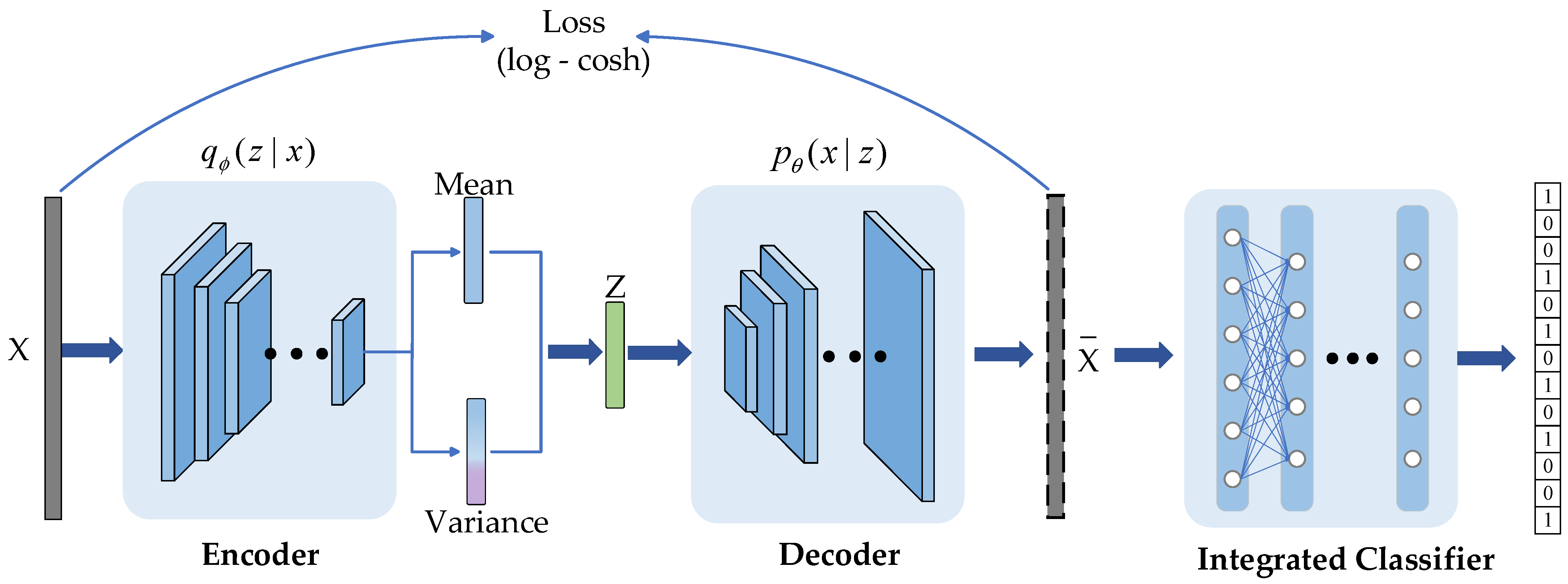
2.1. Log-Cosh Variational Auto Encoder
| Algorithm 1 Train LVAE to generate new or unknown types of attack data |
| Input: data set X. |
| Output: new or unknown type of attack dataset . |
| 1: Data preprocessing: removing redundant information, filling in missing values and normalization. |
| 2: Iteration |
| 3: for number of epochs learned do |
| 4: for mini-batch quantities do |
| 5: The data is input to the encoder to obtain the feature variable Z. |
| 6: The feature variable Z is input to the decoder to obtain the reconstructed data . |
| 7: Backpropagation calculates the loss values and gradients for Equation (5). |
| 8: Gradient descent. |
| 9: end for |
| 10: end for |
| 11: Until Equation (5) converges. |
| 12: Output new or unknown type of attack dataset . |
2.2. Classification Stage
| Algorithm 2 Training Integrated Classifiers |
| Input: data set . |
| Output: Classification results . |
| 1: Data preprocessing: removing redundant information, filling in missing values and normalization. |
| 2: Iteration |
| 3: for c = 1 in rang (1, 9) |
| 4: Input data into the classifier to get the predicted value |
| 5: Backpropagation calculates Equation (6) losses and gradients. |
| 6: Gradient descent. |
| 7: end for |
| 8: Until Equation (6) converges. |
| 9: Output the classification result for each classifier . |
| 10: for c = 1 in rang(1, 9) |
| 11: if ) |
| 12: Output classification result . |
| 13: end if |
| 14: end for |
| 15: Output the classification results . |
2.3. Model Structural Details and Detection Process
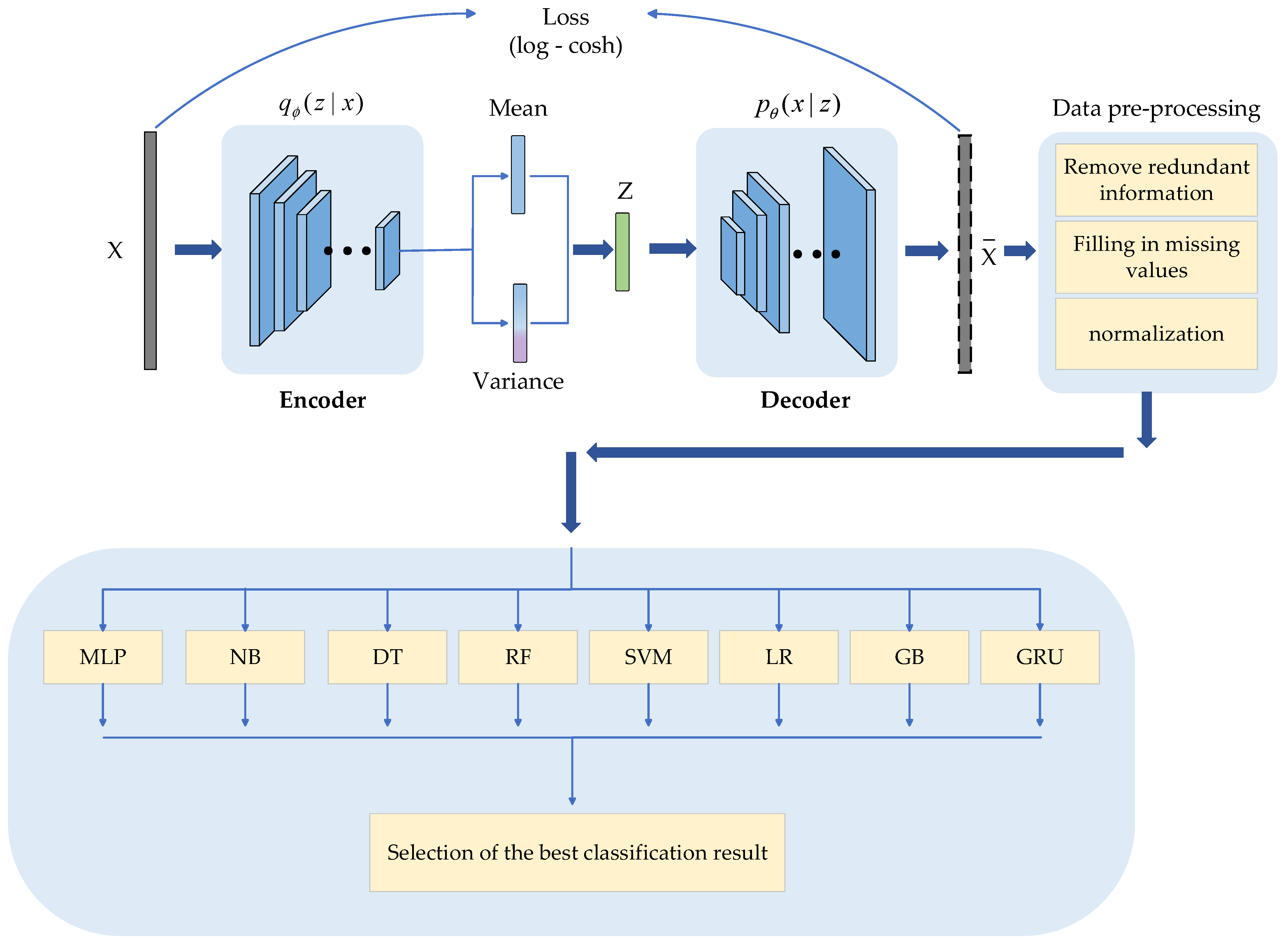
3. Experiments
3.1. Description of the Dataset
| Traffic Class | Label | Numbers | Ratio |
|---|---|---|---|
| Benign | Benign | 2,273,097 | 80.30% |
| DDoS | DDoS | 128,027 | 4.52% |
| DoS | DoS Hulk | 231,073 | 8.16% |
| DoS GoldenEye | 10,293 | 0.36% | |
| DoS Slowloris | 5796 | 0.20% | |
| DoS Slowhttptest | 5499 | 0.19% | |
| Port Scan | Port Scan | 158,930 | 5.61% |
| Botnet | Bot | 1966 | 0.07% |
| Brute Force | FTP-Patator | 7938 | 0.28% |
| SSH-Patator | 5897 | 0.20% | |
| Web Attack | Web Attack—Brute Force | 1507 | 0.05% |
| Web Attack—Sql Injection | 21 | 0.001% | |
| Web Attack—XSS | 652 | 0.02% | |
| Infiltration | Infiltration | 36 | 0.002% |
| Heartbleed | Heartbleed | 11 | 0.001% |
| Total | N | 2,830,743 | 100% |
| Training Set Distribution | Training Dataset | Testing Set Distribution | Testing Dataset |
|---|---|---|---|
| Benign (50%) | 10,000 | Benign 100 | 2000 + 8000 (generated) |
| 20,000 | 2000 + 18,000 (generated) | ||
| 30,000 | 2000 + 28,000 (generated) | ||
| 40,000 | 2000 + 38,000 (generated) | ||
| 50,000 | 2000 + 48,000 (generated) | ||
| Attack (50%) | 60,000 | Attack 1900 | 2000 + 58,000 (generated) |
| 70,000 | 2000 + 68,000 (generated) | ||
| 80,000 | 2000 + 78,000 (generated) | ||
| 90,000 | 2000 + 88,000 (generated) |
3.2. Assessment of Indicators
3.3. Setting of Model Hyperparameters
- Multilayer Perceptron (MLP): The hidden layer consists of 80 nodes with ReLU activation. The model is trained for five epochs with a batch size of five, and the Adam optimizer is used for loss optimization.
- Gaussian-Based Naive Bayes (Gaussian NB): No specific priorities are set.
- Decision Tree (DT): The criterion is set to entropy, and the maximum number of tree layers is set to 4. The remaining parameters use default values.
- Random Forest (RF): The number of estimators is set to 100, while the other parameters use default values.
- Support Vector Machine (SVM): The gamma parameter is set to scale, and C is set to 1.
- Logistic Regression (LR): The penalty is set to L2, C is set to 1, and the maximum number of iterations is set to 1,200,000.
- Gradient Boost (GB): The random state is set to 0.
- Gated Recurrent Unit (GRU): The hidden layer consists of 80 nodes with a sigmoid activation function. The dropout is set to 0.2. The output layer utilizes the softmax activation function. The model is trained for five epochs with a batch size of 10, and the Adam optimizer is used for loss optimization.
4. Results and Discussion
- Experimental Outcomes and Analysis: To evaluate the effectiveness of our LVAE technique, we conducted several experiments. The results clearly demonstrate that our approach is capable of accurately detecting unknown types of attacks. By carefully selecting and fine-tuning the model parameters, we ensure its success against new threats. Furthermore, we improved the overall performance of our method by carefully determining the optimal hyperparameters through experimentation. The specific configuration of these hyperparameters is detailed in Section 3.3.
- Computational Cost Analysis: In order to identify novel or unknown attacks, we integrate eight different techniques in the integrated classifier section. Each technique has a set of carefully chosen parameters that maximize performance. While each approach incurs a different computational cost, we took measures to ensure efficiency without compromising accuracy. The specific configuration of these hyperparameters is detailed in Section 3.3.
4.1. Analysis of Experimental Results
| Number of Samples | Methods | Training (Accuracy) | Testing (Accuracy) | Precision | Recall | F1 |
|---|---|---|---|---|---|---|
| Training (10,000) Testing (10,000) | MLP | 95.44% | 89.65% | 98.63% | 86.68% | 92.27% |
| NB | 80.84% | 97.82% | 98.15% | 97.82% | 97.98% | |
| DT | 88.29% | 98.95% | 98.03% | 98.95% | 98.49% | |
| RF | 99.95% | 98.87% | 98.03% | 98.90% | 98.45% | |
| SVM | 93.36% | 94.07% | 98.06% | 94.08% | 96.03% | |
| LR | 85.09% | 96.40% | 98.02% | 96.41% | 97.21% | |
| GB | 99.65% | 98.88% | 98.04% | 98.88% | 98.46% | |
| GRU | 80.97% | 99.01% | 98.12% | 98.90% | 98.52% | |
| Training (20,000) Testing (20,000) | MLP | 95.19% | 98.63% | 99.27% | 92.49% | 95.76% |
| NB | 63.60% | 94.37% | 99.11% | 94.37% | 96.68% | |
| DT | 91.57% | 97.56% | 99.06% | 97.56% | 98.31% | |
| RF | 99.98% | 99.47% | 99.01% | 99.50% | 99.25% | |
| SVM | 92.95% | 97.12% | 99.03% | 97.13% | 98.07% | |
| LR | 83.35% | 97.23% | 99.02% | 97.23% | 98.12% | |
| GB | 99.24% | 97.55% | 99.01% | 97.55% | 98.27% | |
| GRU | 87.30% | 99.50% | 99.01% | 99.50% | 99.25% | |
| Training (30,000) Testing (30,000) | MLP | 96.13% | 99.02% | 99.42% | 99.30% | 99.36% |
| NB | 79.27% | 3.88% | 93.21% | 3.88% | 7.46% | |
| DT | 91.13% | 98.37% | 99.37% | 98.37% | 98.87% | |
| RF | 99.93% | 99.66% | 99.34% | 99.66% | 99.50% | |
| SVM | 93.62% | 98.08% | 99.35% | 98.08% | 98.71% | |
| LR | 84.39% | 98.17% | 99.34% | 98.18% | 98.76% | |
| GB | 99.09% | 98.91% | 99.35% | 98.92% | 99.13% | |
| GRU | 88.04% | 99.67% | 99.34% | 99.66% | 99.50% |
| Number of Samples | Methods | Training (Accuracy) | Testing (Accuracy) | Precision | Recall | F1 |
|---|---|---|---|---|---|---|
| Training (40,000) Testing (40,000) | MLP | 96.90% | 99.64% | 99.65% | 97.54% | 98.58% |
| NB | 60.49% | 98.65% | 99.55% | 98.65% | 99.10% | |
| DT | 91.73% | 98.77% | 99.53% | 98.78% | 99.15% | |
| RF | 99.97% | 99.73% | 99.50% | 99.75% | 99.63% | |
| SVM | 94.44% | 98.98% | 99.51% | 98.99% | 99.25% | |
| LR | 86.85% | 98.63% | 99.52% | 98.63% | 99.07% | |
| GB | 99.21% | 99.74% | 99.50% | 99.75% | 99.62% | |
| GRU | 91.13% | 99.75% | 99.52% | 99.72% | 99.62% | |
| Training (50,000) Testing (50,000) | MLP | 97.33% | 98.62% | 99.67% | 99.31% | 99.49% |
| NB | 77.73% | 98.94% | 99.64% | 98.94% | 99.29% | |
| DT | 92.07% | 99.03% | 99.62% | 99.03% | 99.33% | |
| RF | 99.94% | 99.80% | 99.60% | 99.80% | 99.70% | |
| SVM | 94.94% | 98.19% | 99.61% | 98.20% | 98.90% | |
| LR | 88.29% | 98.90% | 99.61% | 98.90% | 99.25% | |
| GB | 99.17% | 99.78% | 99.60% | 99.79% | 99.69% | |
| GRU | 93.26% | 99.80% | 99.60% | 99.80% | 99.70% | |
| Training (60,000) Testing (60,000) | MLP | 97.41% | 99.06% | 99.69% | 99.68% | 99.69% |
| NB | 77.71% | 99.13% | 99.70% | 99.14% | 99.42% | |
| DT | 92.56% | 99.18% | 99.67% | 99.19% | 99.43% | |
| RF | 99.99% | 99.83% | 99.67% | 99.83% | 99.75% | |
| SVM | 94.28% | 98.97% | 99.67% | 98.79% | 99.32% | |
| LR | 88.52% | 99.09% | 99.67% | 99.09% | 99.38% | |
| GB | 99.21% | 99.83% | 99.67% | 99.83% | 99.75% | |
| GRU | 93.54% | 99.82% | 99.67% | 99.83% | 99.75% |
| Number of Samples | Methods | Training (Accuracy) | Testing (Accuracy) | Precision | Recall | F1 |
|---|---|---|---|---|---|---|
| Training (70,000) Testing (70,000) | MLP | 97.28% | 99.85% | 99.75% | 99.10% | 99.42% |
| NB | 59.99% | 99.85% | 99.71% | 99.86% | 99.79% | |
| DT | 91.84% | 99.29% | 99.73% | 99.30% | 99.52% | |
| RF | 99.98% | 99.86% | 99.72% | 99.86% | 99.79% | |
| SVM | 92.07% | 97.71% | 99.85% | 97.71% | 98.77% | |
| LR | 87.63% | 99.21% | 99.74% | 99.21% | 99.47% | |
| GB | 99.16% | 99.84% | 99.73% | 99.85% | 99.79% | |
| GRU | 91.12% | 99.86% | 99.73% | 99.84% | 99.78% | |
| Training (80,000) Testing (80,000) | MLP | 97.68% | 99.88% | 99.78% | 99.29% | 99.54% |
| NB | 63.57% | 99.38% | 99.77% | 99.39% | 99.58% | |
| DT | 92.67% | 99.37% | 99.77% | 99.37% | 99.57% | |
| RF | 99.99% | 99.87% | 99.75% | 99.88% | 99.81% | |
| SVM | 95.52% | 98.85% | 99.76% | 98.86% | 99.31% | |
| LR | 89.10% | 99.31% | 99.77% | 99.31% | 99.54% | |
| GB | 99.09% | 99.86% | 99.76% | 99.87% | 99.81% | |
| GRU | 92.97% | 99.87% | 99.75% | 99.88% | 99.81% | |
| Training (90,000) Testing (90,000) | MLP | 97.71% | 99.32% | 99.79% | 99.85% | 99.82% |
| NB | 65.17% | 99.45% | 99.80% | 99.46% | 99.63% | |
| DT | 92.85% | 99.44% | 99.80% | 99.44% | 99.62% | |
| RF | 99.99% | 99.87% | 99.78% | 99.87% | 99.83% | |
| SVM | 95.80% | 99.31% | 99.78% | 99.31% | 99.55% | |
| LR | 89.75% | 99.38% | 99.80% | 99.39% | 99.59% | |
| GB | 99.07% | 99.88% | 99.78% | 99.89% | 99.84% | |
| GRU | 95.32% | 99.89% | 99.78% | 99.87% | 99.83% |
| Reference | Accuracy | Precision | Recall | F1 |
|---|---|---|---|---|
| [16] | 97.28% | ----- | 97% | 72.81% |
| [44] | 92.10% | 59.13% | 49.12% | 97.15% |
| [49] | 96.90% | 97.70% | 97.60% | 97.60% |
| [39] | 89.78% | 91.16% | 95.34% | 93.13% |
| [37] | 99.07% | 98.91% | 98.95% | 98.93% |
| [29] | 97.07% | 97.05% | 97.10% | 97.07% |
| [25] | 91.33% | 99.77% | 89.00% | 94.10% |
| [17] | 97.20% | 81.40% | 83.60% | 82.50% |
| [1] | 98.99% | 96.99% | 89.78% | 93.25% |
| Proposed | 99.88% | 99.78% | 99.89% | 99.84% |
4.2. Calculated Cost Analysis of the Various Components of the LVAE Methodology
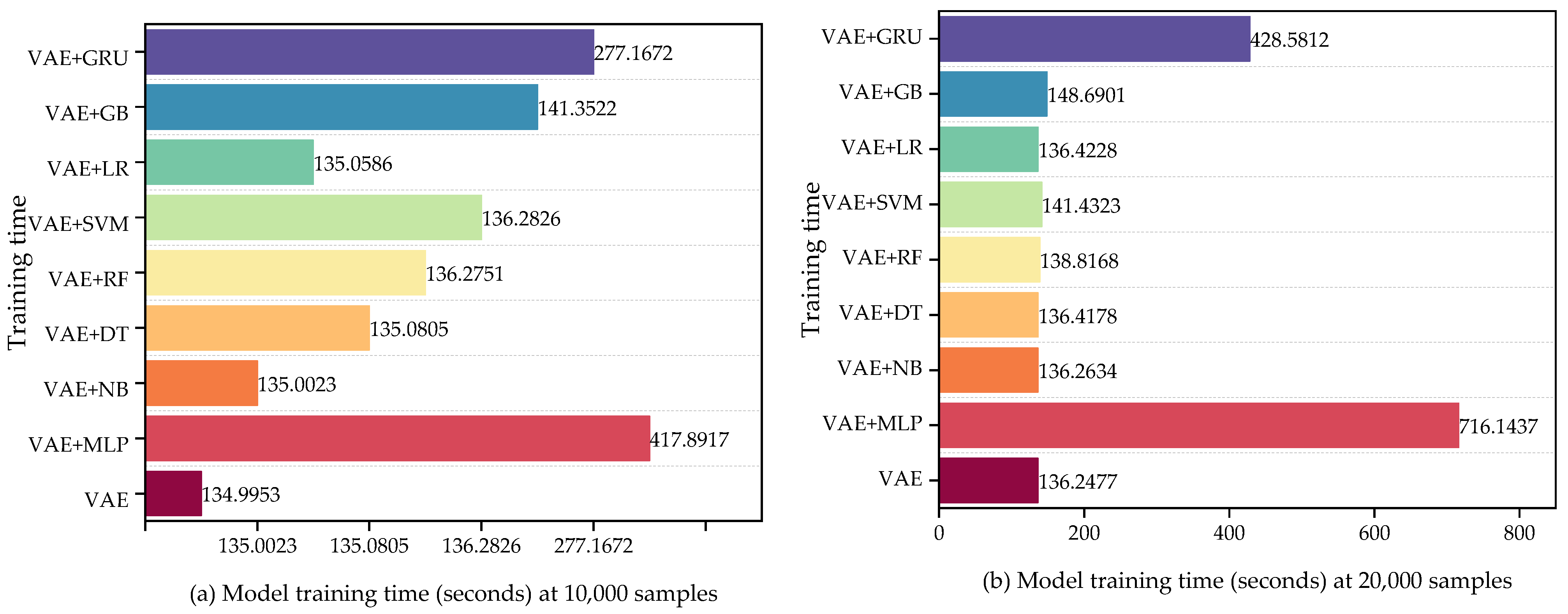
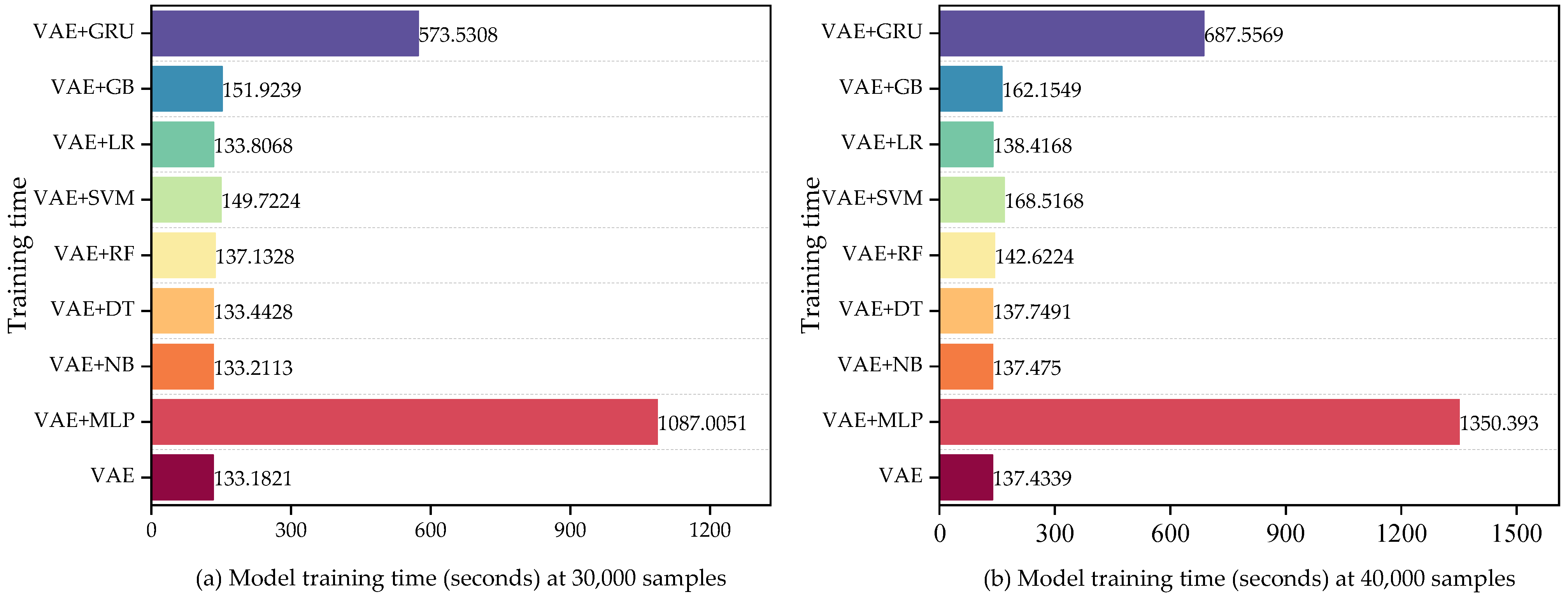
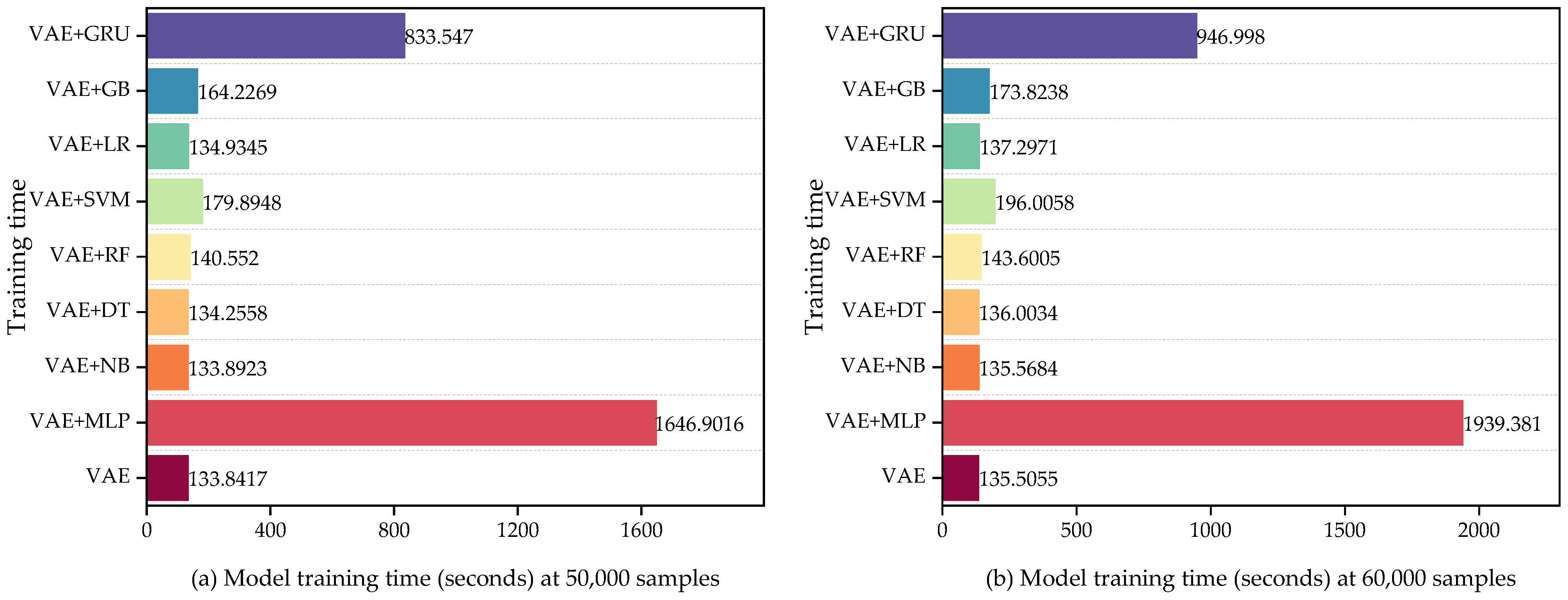
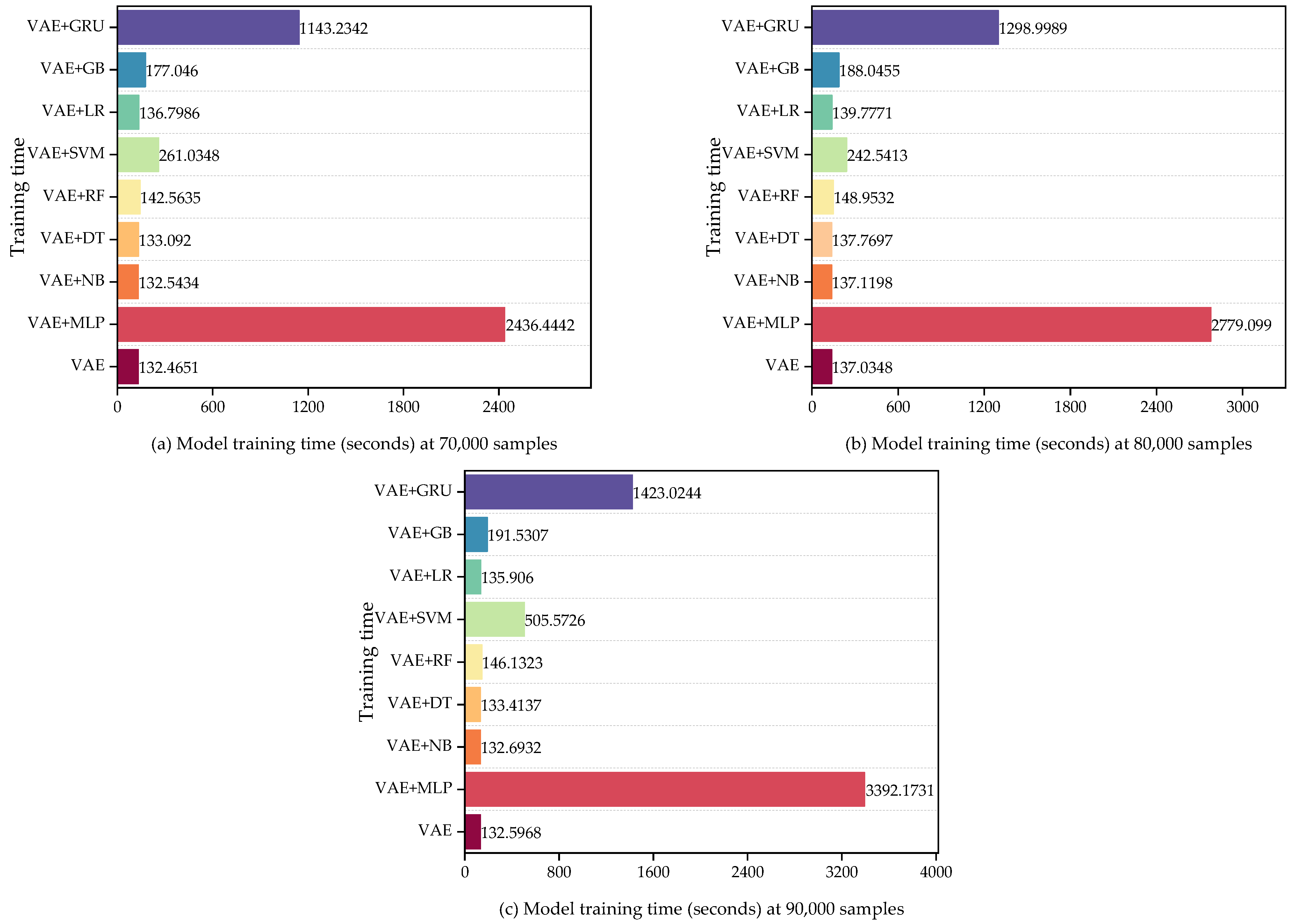
5. Conclusions
Author Contributions
Funding
Institutional Review Board Statement
Informed Consent Statement
Data Availability Statement
Acknowledgments
Conflicts of Interest
References
- Dong, S.; Xia, Y.; Peng, T. Network Abnormal Traffic Detection Model Based on Semi-Supervised Deep Reinforcement Learning. IEEE Trans. Netw. Serv. Manag. 2021, 18, 4197–4212. [Google Scholar] [CrossRef]
- Alahmed, S.; Alasad, Q.; Hammood, M.M.; Yuan, J.-S.; Alawad, M. Mitigation of Black-Box Attacks on Intrusion Detection Systems-Based ML. Computers 2022, 11, 115. [Google Scholar] [CrossRef]
- Ahmad, S.; Arif, F.; Zabeehullah, Z.; Iltaf, N. Novel Approach Using Deep Learning for Intrusion Detection and Classification of the Network Traffic. In Proceedings of the 2020 IEEE International Conference on Computational Intelligence and Virtual Environments for Measurement Systems and Applications (CIVEMSA), Tunis, Tunisia, 22–24 June 2020; pp. 1–6. [Google Scholar]
- Rigaki, M. Adversarial Deep Learning against Intrusion Detection Classifiers. In Proceedings of the IST-152 Workshop on Intelligent Autonomous Agents for Cyber Defence and Resilience, Prague, Czech Republic, 18–20 October 2017. [Google Scholar]
- Alasad, Q.; Hammood, M.M.; Alahmed, S. Performance and Complexity Tradeoffs of Feature Selection on Intrusion Detection System-Based Neural Network Classification with High-Dimensional Dataset. In Proceedings of the 2nd International Conference on Emerging Technologies and Intelligent Systems, Online, 2–3 September 2022; pp. 533–542. [Google Scholar]
- Tian, Y.; Mirzabagheri, M.; Bamakan, S.M.H.; Wang, H.; Qu, Q. Ramp loss one-class support vector machine; A robust and effective approach to anomaly detection problems. Neurocomputing 2018, 310, 223–235. [Google Scholar] [CrossRef]
- Kamarudin, M.H.; Maple, C.; Watson, T.; Safa, N.S. A LogitBoost-Based Algorithm for Detecting Known and Unknown Web Attacks. IEEE Access 2017, 5, 26190–26200. [Google Scholar] [CrossRef]
- Ahmad, R.; Alsmadi, I.; Alhamdani, W.; Tawalbeh, L. A Deep Learning Ensemble Approach to Detecting Unknown Network Attacks. J. Inf. Secur. Appl. 2022, 67, 103196. [Google Scholar] [CrossRef]
- Liu, Y.; Chen, K.; Liao, X.; Zhang, W. A genetic clustering method for intrusion detection. Pattern Recognit. 2004, 37, 927–942. [Google Scholar] [CrossRef]
- Xu, X.; Shen, F.; Yang, Y.; Shen, H.T.; Li, X. Learning Discriminative Binary Codes for Large-scale Cross-modal Retrieval. IEEE Trans. Image Process. 2017, 26, 2494–2507. [Google Scholar] [CrossRef] [PubMed]
- Luo, Y.; Yang, Y.; Shen, F.; Huang, Z.; Zhou, P.; Shen, H.T. Robust discrete code modeling for supervised hashing. Pattern Recognit. 2018, 75, 128–135. [Google Scholar] [CrossRef]
- Hu, M.; Yang, Y.; Shen, F.; Xie, N.; Shen, H.T. Hashing with Angular Reconstructive Embeddings. IEEE Trans. Image Process. 2018, 27, 545–555. [Google Scholar] [CrossRef] [PubMed]
- Xu, X.; Lu, H.; Song, J.; Yang, Y.; Shen, H.T.; Li, X. Ternary Adversarial Networks with Self-Supervision for Zero-Shot Cross-Modal Retrieval. IEEE Trans. Cybern. 2020, 50, 2400–2413. [Google Scholar] [CrossRef]
- Aziz, M.F.; Khan, A.N.; Shuja, J.; Khan, I.A.; Khan, F.G.; Khan, A.U.R. A lightweight and compromise-resilient authentication scheme for IoTs. Trans. Emerg. Telecommun. Technol. 2022, 33, e3813. [Google Scholar] [CrossRef]
- Jan, S.A.; Amin, N.U.; Shuja, J.; Abbas, A.; Maray, M.; Ali, M. SELWAK: A Secure and Efficient Lightweight and Anonymous Authentication and Key Establishment Scheme for IoT Based Vehicular Ad hoc Networks. Sensors 2022, 22, 4019. [Google Scholar] [CrossRef]
- Lee, J.-S.; Chen, Y.-C.; Chew, C.-J.; Chen, C.-L.; Huynh, T.-N.; Kuo, C.-W. CoNN-IDS: Intrusion detection system based on collaborative neural networks and agile training. Comput. Secur. 2022, 122, 102908. [Google Scholar] [CrossRef]
- Lopez-Martin, M.; Sanchez-Esguevillas, A.; Arribas, J.I.; Carro, B. Contrastive Learning over Random Fourier Features for IoT Network Intrusion Detection. IEEE Internet Things J. 2023, 10, 8505–8513. [Google Scholar] [CrossRef]
- Singh, A.; Chatterjee, K.; Satapathy, S.C. An edge based hybrid intrusion detection framework for mobile edge computing. Complex Intell. Syst. 2022, 8, 3719–3746. [Google Scholar] [CrossRef]
- Zoppi, T.; Ceccarelli, A.; Puccetti, T.; Bondavalli, A. Which algorithm can detect unknown attacks? Comparison of supervised, unsupervised and meta-learning algorithms for intrusion detection. Comput. Secur. 2023, 127, 103107. [Google Scholar] [CrossRef]
- Boukela, L.; Zhang, G.; Yacoub, M.; Bouzefrane, S. A near-autonomous and incremental intrusion detection system through active learning of known and unknown attacks. In Proceedings of the 2021 International Conference on Security, Pattern Analysis, and Cybernetics (SPAC), Chengdu, China, 18–20 June 2021; pp. 374–379. [Google Scholar]
- Soltani, M.; Ousat, B.; Jafari Siavoshani, M.; Jahangir, A.H. An adaptable deep learning-based intrusion detection system to zero-day attacks. J. Inf. Secur. Appl. 2023, 76, 103516. [Google Scholar] [CrossRef]
- Mahdavi, E.; Fanian, A.; Mirzaei, A.; Taghiyarrenani, Z. ITL-IDS: Incremental Transfer Learning for Intrusion Detection Systems. Knowl.-Based Syst. 2022, 253, 109542. [Google Scholar] [CrossRef]
- Mananayaka, A.K.; Chung, S.S. Network Intrusion Detection with Two-Phased Hybrid Ensemble Learning and Automatic Feature Selection. IEEE Access 2023, 11, 45154–45167. [Google Scholar] [CrossRef]
- Zhou, X.; Liang, W.; Li, W.; Yan, K.; Shimizu, S.; Wang, K.I.K. Hierarchical Adversarial Attacks Against Graph-Neural-Network-Based IoT Network Intrusion Detection System. IEEE Internet Things J. 2022, 9, 9310–9319. [Google Scholar] [CrossRef]
- Kumar, V.; Sinha, D. A robust intelligent zero-day cyber-attack detection technique. Complex Intell. Syst. 2021, 7, 2211–2234. [Google Scholar] [CrossRef] [PubMed]
- Sarhan, M.; Layeghy, S.; Gallagher, M.; Portmann, M. From zero-shot machine learning to zero-day attack detection. Int. J. Inf. Secur. 2023, 22, 947–959. [Google Scholar] [CrossRef]
- Sheng, C.; Yao, Y.; Li, W.; Yang, W.; Liu, Y. Unknown Attack Traffic Classification in SCADA Network Using Heuristic Clustering Technique. IEEE Trans. Netw. Serv. Manag. 2023, 20, 2625–2638. [Google Scholar] [CrossRef]
- Hairab, B.I.; Elsayed, M.S.; Jurcut, A.D.; Azer, M.A. Anomaly Detection Based on CNN and Regularization Techniques against Zero-Day Attacks in IoT Networks. IEEE Access 2022, 10, 98427–98440. [Google Scholar] [CrossRef]
- de Araujo-Filho, P.F.; Naili, M.; Kaddoum, G.; Fapi, E.T.; Zhu, Z. Unsupervised GAN-Based Intrusion Detection System Using Temporal Convolutional Networks and Self-Attention. IEEE Trans. Netw. Serv. Manag. 2023. [Google Scholar] [CrossRef]
- Verkerken, M.; D’hooge, L.; Sudyana, D.; Lin, Y.D.; Wauters, T.; Volckaert, B.; Turck, F.D. A Novel Multi-Stage Approach for Hierarchical Intrusion Detection. IEEE Trans. Netw. Serv. Manag. 2023, 20, 3915–3929. [Google Scholar] [CrossRef]
- Sohi, S.M.; Seifert, J.-P.; Ganji, F. RNNIDS: Enhancing network intrusion detection systems through deep learning. Comput. Secur. 2021, 102, 102151. [Google Scholar] [CrossRef]
- Moustafa, N.; Keshk, M.; Choo, K.-K.R.; Lynar, T.; Camtepe, S.; Whitty, M. DAD: A Distributed Anomaly Detection system using ensemble one-class statistical learning in edge networks. Future Gener. Comput. Syst. 2021, 118, 240–251. [Google Scholar] [CrossRef]
- Debicha, I.; Bauwens, R.; Debatty, T.; Dricot, J.-M.; Kenaza, T.; Mees, W. TAD: Transfer learning-based multi-adversarial detection of evasion attacks against network intrusion detection systems. Future Gener. Comput. Syst. 2023, 138, 185–197. [Google Scholar] [CrossRef]
- Dina, A.S.; Manivannan, D. Intrusion detection based on Machine Learning techniques in computer networks. Internet Things 2021, 16, 100462. [Google Scholar] [CrossRef]
- Lai, Y.C.; Sudyana, D.; Lin, Y.D.; Verkerken, M.; D’hooge, L.; Wauters, T.; Volckaert, B.; Turck, F.D. Task Assignment and Capacity Allocation for ML-Based Intrusion Detection as a Service in a Multi-Tier Architecture. IEEE Trans. Netw. Serv. Manag. 2023, 20, 672–683. [Google Scholar] [CrossRef]
- Sabeel, U.; Heydari, S.S.; El-Khatib, K.; Elgazzar, K. Unknown, Atypical and Polymorphic Network Intrusion Detection: A Systematic Survey. IEEE Trans. Netw. Serv. Manag. 2023. [Google Scholar] [CrossRef]
- Rani, S.V.J.; Ioannou, I.; Nagaradjane, P.; Christophorou, C.; Vassiliou, V.; Yarramsetti, H.; Shridhar, S.; Balaji, L.M.; Pitsillides, A. A Novel Deep Hierarchical Machine Learning Approach for Identification of Known and Unknown Multiple Security Attacks in a D2D Communications Network. IEEE Access 2023. [Google Scholar] [CrossRef]
- Lu, C.; Wang, X.; Yang, A.; Liu, Y.; Dong, Z. A Few-Shot Based Model-Agnostic Meta-Learning for Intrusion Detection in Security of Internet of Things. IEEE Internet Things J. 2023. [Google Scholar] [CrossRef]
- Shin, G.Y.; Kim, D.W.; Han, M.M. Data Discretization and Decision Boundary Data Point Analysis for Unknown Attack Detection. IEEE Access 2022, 10, 114008–114015. [Google Scholar] [CrossRef]
- Lan, J.; Liu, X.; Li, B.; Zhao, J. A novel hierarchical attention-based triplet network with unsupervised domain adaptation for network intrusion detection. Appl. Intell. 2023, 53, 11705–11726. [Google Scholar] [CrossRef]
- Zavrak, S.; İskefiyeli, M. Anomaly-Based Intrusion Detection from Network Flow Features Using Variational Autoencoder. IEEE Access 2020, 8, 108346–108358. [Google Scholar] [CrossRef]
- Vu, L.; Nguyen, Q.U.; Nguyen, D.N.; Hoang, D.T.; Dutkiewicz, E. Deep Generative Learning Models for Cloud Intrusion Detection Systems. IEEE Trans. Cybern. 2023, 53, 565–577. [Google Scholar] [CrossRef]
- Long, C.; Xiao, J.; Wei, J.; Zhao, J.; Wan, W.; Du, G. Autoencoder ensembles for network intrusion detection. In Proceedings of the 2022 24th International Conference on Advanced Communication Technology (ICACT), Pyeongchang, Republic of Korea, 13–16 February 2022; pp. 323–333. [Google Scholar]
- Yang, J.; Chen, X.; Chen, S.; Jiang, X.; Tan, X. Conditional Variational Auto-Encoder and Extreme Value Theory Aided Two-Stage Learning Approach for Intelligent Fine-Grained Known/Unknown Intrusion Detection. IEEE Trans. Inf. Forensics Secur. 2021, 16, 3538–3553. [Google Scholar] [CrossRef]
- Abdalgawad, N.; Sajun, A.; Kaddoura, Y.; Zualkernan, I.A.; Aloul, F. Generative Deep Learning to Detect Cyberattacks for the IoT-23 Dataset. IEEE Access 2022, 10, 6430–6441. [Google Scholar] [CrossRef]
- Jin, D.; Chen, S.; He, H.; Jiang, X.; Cheng, S.; Yang, J. Federated Incremental Learning based Evolvable Intrusion Detection System for Zero-Day Attacks. IEEE Netw. 2023, 37, 125–132. [Google Scholar] [CrossRef]
- Yang, L.; Song, Y.; Gao, S.; Hu, A.; Xiao, B. Griffin: Real-Time Network Intrusion Detection System via Ensemble of Autoencoder in SDN. IEEE Trans. Netw. Serv. Manag. 2022, 19, 2269–2281. [Google Scholar] [CrossRef]
- Zahoora, U.; Rajarajan, M.; Pan, Z.; Khan, A. Zero-Day Ransomware Attack Detection Using Deep Contractive Autoencoder and Voting Based Ensemble Classifier. Appl. Intell. 2022, 52, 13941–13960. [Google Scholar] [CrossRef]
- Boppana, T.K.; Bagade, P. GAN-AE: An unsupervised intrusion detection system for MQTT networks. Eng. Appl. Artif. Intell. 2023, 119, 105805. [Google Scholar] [CrossRef]
- Kim, C.; Chang, S.Y.; Kim, J.; Lee, D.; Kim, J. Automated, Reliable Zero-Day Malware Detection Based on Autoencoding Architecture. IEEE Trans. Netw. Serv. Manag. 2023, 20, 3900–3914. [Google Scholar] [CrossRef]
- Li, R.; Li, Q.; Zhou, J.; Jiang, Y. ADRIoT: An Edge-Assisted Anomaly Detection Framework against IoT-Based Network Attacks. IEEE Internet Things J. 2022, 9, 10576–10587. [Google Scholar] [CrossRef]
- Li, Z.; Chen, S.; Dai, H.; Xu, D.; Chu, C.K.; Xiao, B. Abnormal Traffic Detection: Traffic Feature Extraction and DAE-GAN with Efficient Data Augmentation. IEEE Trans. Reliab. 2023, 72, 498–510. [Google Scholar] [CrossRef]
- Sharafaldin, I.; Lashkari, A.H.; Ghorbani, A.A. Toward generating a new intrusion detection dataset and intrusion traffic characterization. ICISSP 2018, 1, 108–116. [Google Scholar]
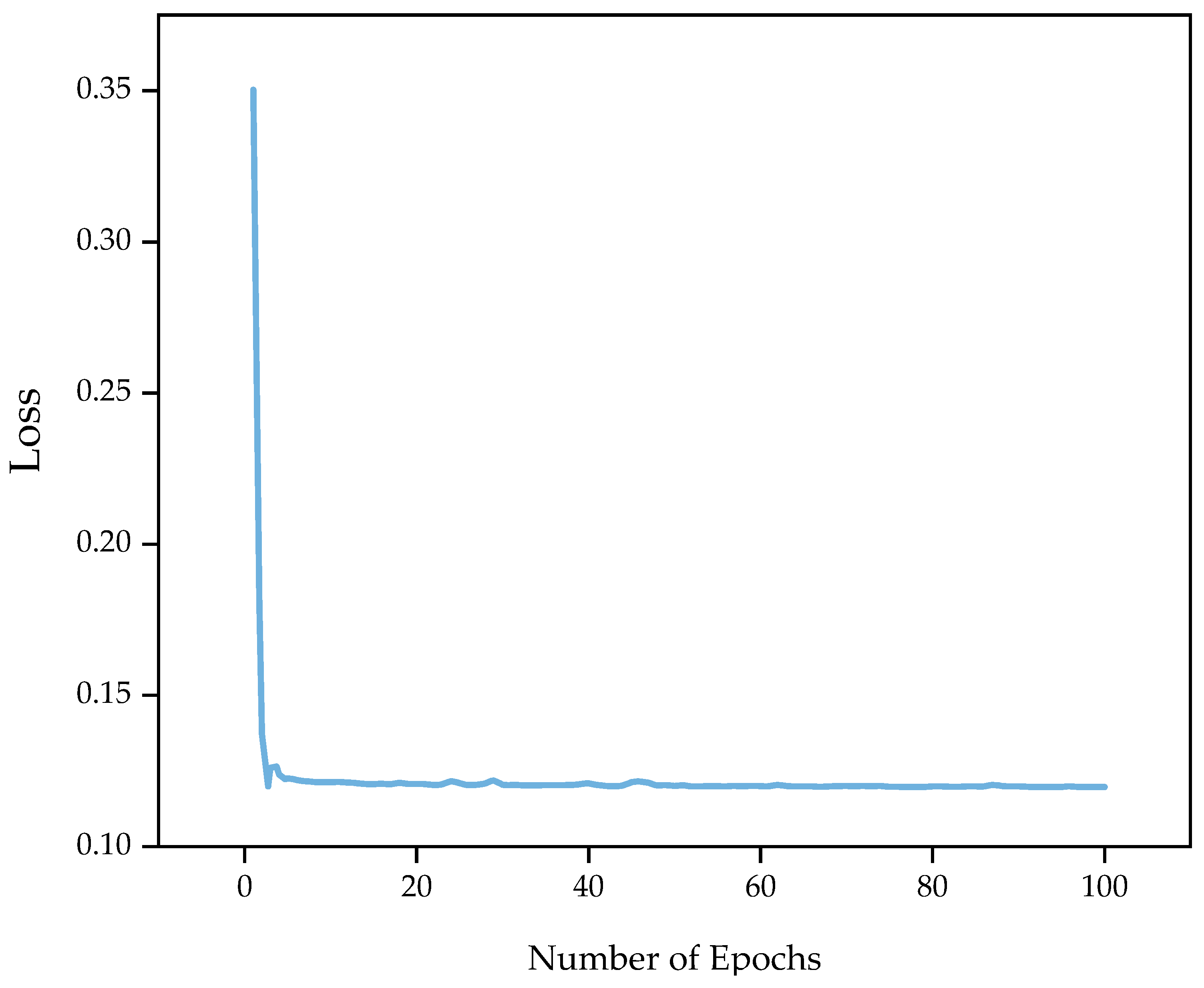
Disclaimer/Publisher’s Note: The statements, opinions and data contained in all publications are solely those of the individual author(s) and contributor(s) and not of MDPI and/or the editor(s). MDPI and/or the editor(s) disclaim responsibility for any injury to people or property resulting from any ideas, methods, instructions or products referred to in the content. |
© 2023 by the authors. Licensee MDPI, Basel, Switzerland. This article is an open access article distributed under the terms and conditions of the Creative Commons Attribution (CC BY) license (https://creativecommons.org/licenses/by/4.0/).
Share and Cite
Yu, L.; Xu, L.; Jiang, X. An Effective Method for Detecting Unknown Types of Attacks Based on Log-Cosh Variational Autoencoder. Appl. Sci. 2023, 13, 12492. https://doi.org/10.3390/app132212492
Yu L, Xu L, Jiang X. An Effective Method for Detecting Unknown Types of Attacks Based on Log-Cosh Variational Autoencoder. Applied Sciences. 2023; 13(22):12492. https://doi.org/10.3390/app132212492
Chicago/Turabian StyleYu, Li, Liuquan Xu, and Xuefeng Jiang. 2023. "An Effective Method for Detecting Unknown Types of Attacks Based on Log-Cosh Variational Autoencoder" Applied Sciences 13, no. 22: 12492. https://doi.org/10.3390/app132212492
APA StyleYu, L., Xu, L., & Jiang, X. (2023). An Effective Method for Detecting Unknown Types of Attacks Based on Log-Cosh Variational Autoencoder. Applied Sciences, 13(22), 12492. https://doi.org/10.3390/app132212492






